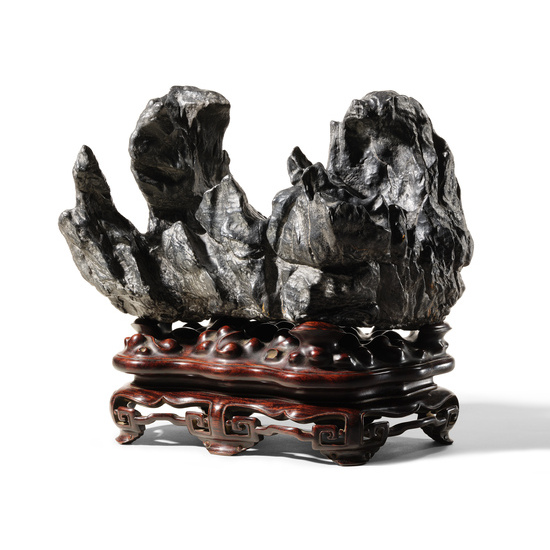CATALOGUE 2024
QING DYNASTY (1644-1911)
LENGTH: 39CM
The lustrous metallic stone is horizontally orientated,
composing of undulating cresting cliffs of varying
heights interrupted by multiple elliptical cavities forming
narrow meandering passageways between the peaks.
The limestone is of a dark grey tone with white veins
predominantly near the base and occasional russet flecks
to the lower right. The reverse is etched with a poetic
inscription dated to xinwei year of the Jiaqing reign
嘉慶辛未 (corresponding to 1811) and signed Qian
Bojong 錢伯坰 (1738-1812), followed by his personal
seal reading Lusi 魯思 (“Thoughts of Lu” which refers to
the native place of Confucius). The rock rests on a carved
double-tiered Suzhou-style stand.
The inscription on the reverse of the rock reads:
| 洞壑窈窕冰雪生 | In deep ravines gracefully arrayed ice and snow form |
| 峰巒槎枒雲物積 | On mountain ridges irregularly jagged clouds gather. |
The two lines are a couplet from “Dali shiping ge wei
shaofu Liu Gongfu” 大理石屏歌為少傅劉公賦 (Dali Stone
Screen Song for Liu Gongfu) by Wang Shizhen 王士禎
(1634-1711). See Wang Shizhen quanji 王士禎全集
(Complete Works of Wang Shizhen). Ed. Yuan Shishuo
袁世碩, Jin’nan, 2007, 1:216.
The poetic inscription on the rock is adapted from the
ghost fiction Quqiu er menglu 渠丘耳夢錄 (“Strange
Tales from Quqiu’s Dreams”), published in 1709 by the
Qing dynasty scholar Zhang Zhen 張貞 active during the
Kangxi period.
Qian Bojiong 錢伯坰 (1738-1812), personal name Lusi
魯斯 and 魯思, sobriquet Yeyu 野餘 , Pushe shan jiao
僕射山樵 (Wood Gatherer of Mount Pushe), and Jiannan
jushi 見南居士 (Looking South Lay Scholar), was a
native of Yanghu 陽湖 (present-day Changzhou 常州 ,
Jiangsu). During the Qianlong era Qian was a student
at the Guozi jian 國子監 (Imperial College), and became
a disciple of Liu Dakui 劉大櫆 (1698-1779) in Beijing,
from whom he learned the meaning and method of
the Tongcheng 桐城 school of prose. He then promoted
Liu Dakui’s teachings in Yanghu and so established the
Yanghu school of ancient-style prose.
In 1794 he joined the staff of the governor-general
of Hu-Guang province Bi Yuan 畢沅 (1730-1797) but
never held an offical appointment himself. Qian was
an accomplished poet and left a work in four stitched
volumes entitled Pushe shanfang shiji 僕射山房詩集
(Poetry Collection from Pushe Mountain Lodge). He was
also a superb calligrapher, famous in his own time of
whom it was said that since the death of Liu Yong 劉墉
(1719-1804) he was the very best at zheng 正 (regular)
and xingshu 行書 (running script). His calligraphy and the
paintings of Bi Han 畢涵 (1732-1807) were jointly praised
in the popular expression “Bi Ling shuhua shuangjue”
毗陵書畫雙絕 (Biling’s Peerless Pair in Calligraphy
and Painting). Biling was a district now included in
Changzhou city.
PROVENANCE
Collection of Qian Bojong 錢伯坰 (1738-1812)
| 清代 | 靈璧石山子 |
| 「嘉慶辛未」 | 「錢伯坰」款 |
